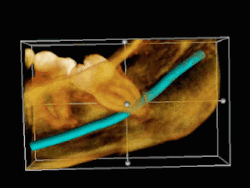| Cone beam computed tomography | |
|---|---|
 Cone Beam CT scanner | |
| MeSH | D054894 |
Cone beam computed tomography (or CBCT, also referred to as C-arm CT, cone beam volume CT, flat panel CT or Digital Volume Tomography (DVT)) is a medical imaging technique consisting of X-ray computed tomography where the X-rays are divergent, forming a cone. [1]
Contents
- History
- Oral and Maxillofacial Radiology
- Radiotherapy
- Interventional radiology
- Applications
- Endodontics
- Implantology
- Orthodontics
- Orthopedics
- Image-guided radiation therapy
- Interventional radiology 2
- Industrial applications
- Reconstruction
- Risks
- Oral and maxillofacial radiology 2
- Disadvantages
- Oral and maxillofacial radiology 3
- Interventional radiology 3
- See also
- References
- Further reading
CBCT has become increasingly important in treatment planning and diagnosis in implant dentistry, ENT, orthopedics, and interventional radiology (IR), among other things. Because of increased access to the technology, CBCT scanners are now widely used in dentistry, such as in the fields of oral surgery, endodontics and orthodontics. Integrated CBCT is also an important tool for patient positioning and verification in image-guided radiation therapy (IGRT).
During dental and orthodontic imaging, the CBCT scanner rotates around the patient's head, acquiring up to 600 distinct images. For interventional radiology, the patient is positioned offset to the table so that the region of interest is centered in the field of view for the cone beam. A single 200 degree rotation over the region of interest acquires a volumetric data set. The scanning software collects the data and reconstructs it, producing what is termed a digital volume composed of three-dimensional voxels of anatomical data that can then be manipulated and visualized with specialized software. [2] [3] CBCT shares many similarities with traditional (fan beam) CT however there are important differences, particularly for reconstruction. CBCT has been described as the gold standard for imaging the oral and maxillofacial area.










